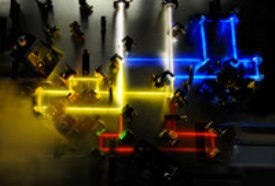Ultrashort flashes of light are required to monitor the ultrafast motion of electrons that spin at very high speeds and the massive forces that act on the electrons. For controlling the structure of these ultrashort light flashes, the flashes themselves have to be controlled.
 A light field synthesizer divides incident white light into three color channels and modifies it afterwards. The composition creates laser pulses with a complex, however fine adjustable waveform.
A light field synthesizer divides incident white light into three color channels and modifies it afterwards. The composition creates laser pulses with a complex, however fine adjustable waveform.
A team of researchers belonging to the Max Planck Institute of Quantum Optics, Ludwig-Maximilians-Universität, the King Saud University and the Center of Free-Electron Laser Science (DESY Hamburg) have collaborated and achieved control of the structure of ultrashort light flashes. They generated “white” light pulses and also controlled them on a sub-cycle time scale. This advancement would enable precise control of motion of electrons and facilitate accurate timing of electronic processes in atoms and molecules.
Electron motion occurs at an attosecond time scale. Laser-generated light takes around 2.6 femtoseconds to complete an oscillation. Hence light is an excellent means of controlling electron dynamics. The research team used white laser light, created pulses and sent them into a novel light field synthesizer. The synthesizer superimposed optical waves of diverse colors and phases, and created different types of field shapes. The apparatus split white laser light into three channels - red, blue and yellow. The properties of the three colors were manipulated and then recombined so as to form a synthesized wave form.
The synthesized light pulses provided the required precision necessary for steering the motion of electrons at microscopic levels. The achievement has helped control the fine structuring of ultra-short light fields, and could lead to future light-based electronics.